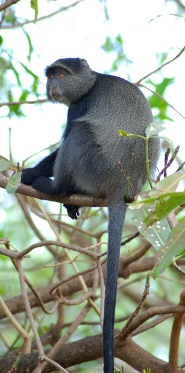 The Blue Monkey (Cercopithecus mitis) also known as the Diademed Monkey is a member of the guenon genus. It is native to East and Central Africa, Ranging from the northern part of the Congo River Basin to the east of the Great Rift Valley and to the south of northern Zambia and Angola.
The Blue Monkey (Cercopithecus mitis) also known as the Diademed Monkey is a member of the guenon genus. It is native to East and Central Africa, Ranging from the northern part of the Congo River Basin to the east of the Great Rift Valley and to the south of northern Zambia and Angola.Although, called 'Blue Monkey', the 'blue' is not really noticeable. The small hair on its face sometimes gives the impression of blue color and hence its name. Apart from its face, its coat is grey or olive in color and there is a yellowish patch on its forehead called the 'Diadem' from which the name Diademed Monkey has been derived. Its legs, feet, and cap are black and the mantle is brown, grey, or olive depending on the species. The Blue Monkey has pouch in its cheeks to carry food while foraging. An average mature blue monkey is 19.68 - 25.59 inches (50 - 65 cm) long and the length of its tail is equal to the length of the rest of its body. The female blue monkey weighs about 8.81 lbs (over 4 kg) and the weight of the male is about 17.63 lbs (8 kg).
The Blue Monkey is mainly found in bamboo forests, evergreen forests, and in thick forest canopies. It very rarely comes to the ground.
The Blue Monkey males are larger than the females. Females generally give birth once in two years during the start of warm, moist rainy seasons. The gestation period lasts for about 5 months. Infants take birth with their eyes open and fur all over their body. The Blue Monkey roosts in groups of 10-40 individuals with only one adult male.
This species believes in the unmale-per-group tendency and the male receives the copulations from the females in the group. The male guards the group from any predators and females also join him in this activity. The stronger male sometimes ousts the male thereby overtaking the troop. In order to protect themselves from predators, these Blue Monkeys get mixed with other species of monkeys. No competition is seen between the two groups since they forage in diverse locations.
This species has a variety of habitats but it always stays close to water. Somalia, Angola, South Africa, Zambia, Zimbabwe, Uganda, Tanzania, Sudan, Malawi, Kenya Burundi, Ethiopia, Zaire, Rwanda, and Mozambique are countries where the Blue Monkey is found in abundance.
Picture of the blue monkey by Pedro Gonnet, licensed under Creative Commons Attribution 2.5 License.
Keywords: blue
The Blue monkey, diademed monkey, golden monkey, samango, sykes' monkey is listed as Least Concern (LR/lc), lowest risk. Does not qualify for a more at risk category. Widespread and abundant taxa are included in this category, on the IUCN Red List of Threatened Species
Namings for the blue monkey
A young / baby of a blue monkey is called a 'infant'. A blue monkey group is called a 'troop, barrel, tribe or cartload'.Countries
Angola, Burundi, Congo, Democratic Republic of the, Ethiopia, Kenya, Malawi, Mozambique, Rwanda, Somalia, South Africa, Sudan, Swaziland, Tanzania, Uganda, Zambia and ZimbabweSome facts about the
Blue monkey
Adult weight : 9 kg (19.8 lbs)
Maximum longevity : 38 years
Female maturity :1673 days
Male maturity : 1673 days
Gestation : 132 days
Weaning : 315 days
Litter size : 1
Litters per year : 1
Interval between litters : 515 days
Weight at birth : 0.366 kg (0.8052 lbs)
Basal metabolic rate : 19 W
Body mass : 8.649 kg (19.0278 lbs)
Temperature : 37.85 °C (100.13 °F)

Custom Search